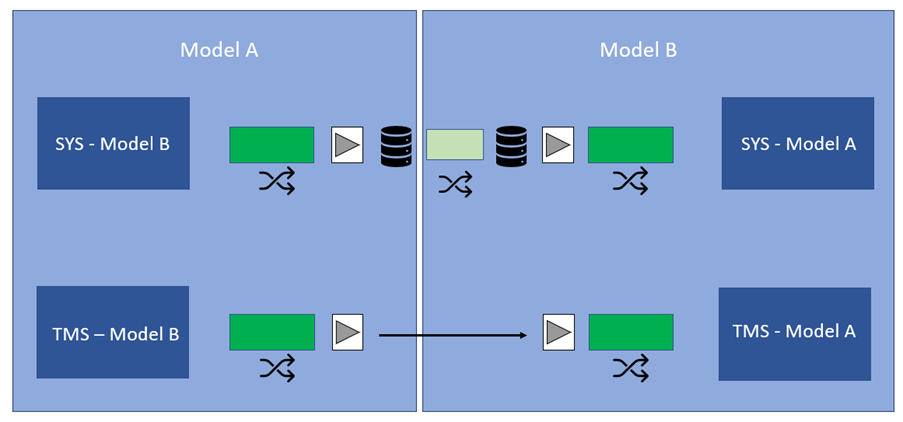In this fundamental, the best practices for the eMagiz multi-model environment will be discussed and illustrated.
Should you have any questions, please get in touch with academy@emagiz.com.
1. Prerequisites
- Some context on the eMagiz multi-model environment and integration patterns will be useful:
- Fundamental eMagiz Multi-model
- Fundamental eMagiz Event Streaming
- Fundamental eMagiz API Gateway
- Fundamental eMagiz Messaging
2. Key concepts
- Event streaming and webervices are mainly used to communicate between systems across models.
- To allow communication between systems in different models using event streaming, it is needed to transform topics.
- Communication between systems in different models can also directly be achieved using web services.
- For clarity purposes, it is advised to give the systems that are the same across models the same name, as well as the name of the other model in which the system is present.
3. Main multi-model integration patterns
At the moment, there are two most frequently used ways to provide communication between systems in a multi-model environment. These concern event streaming and webservices. The processes of sharing data across systems in a multi-model environment using these concepts will be discussed in this microlearning, including best practices.
In the figure below, both processes are illustrated. The process at the top illustrates event streaming, the process at the bottom webservices. Model A and model B are two different models, where a system in model B should have access to the same data as the system in model A. I.e., the systems in both models should be the same.

3.1 Event streaming
To understand the following section, it is necessary to have some background information about event streaming, which can be found here.
To allow communication between systems in different models using event streaming, it is needed to transform topics. The reason for this, is that it is not possible to retrieve data from a topic existent in one model through a different model. So, the topic present in model A cannot be immediately accessed by systems present in model B. To ensure that systems in model B can use the data on the topic in model A, the topic needs to be transformed. By transforming the topic, all systems in model B can access the transformed topic.
To ensure that the topic from model A can be transformed, model B needs credentials from model A. So, to allow for this pattern, credentials have to be shared between models.
An advantage of this pattern is that there is no dependency across models. If the system in model A breaks down, the system in model B can still work. A disadvantage of this pattern is that there may be struggles with the setup, since no direct accessibility can be achieved. Moreover, as mentioned above, credentials have to be shared, which may be a threat to the security.
3.2 Webservices
Communication between systems in different models can also be achieved using web services. This means that model A has a webservice in place, and model B has a webservice in place, between which data can be exchanged.
An advantage of this pattern is that it is easy to keep an overview, there are not many unclarities in setting it up. A disadvantage of this pattern is that there is much dependency across models. If the webservice in model A crashes, the system in model B cannot receive data anymore.
3.3 Naming conventions
For clarity purposes, it is advised to give the systems that are the same across models the same name, as well as the name of the other model in which the system is present. So, as illustrated in the figure, the system names in model A and B are partly the same (‘SYS’), and indicate which model also holds the system (model B in model A, model A in model B). This way, it remains clear in which models the same systems are present, and systems can be found more easily.
4. Key takeaways
- Event streaming and webervices are mainly used to communicate between systems across models.
- To allow communication between systems in different models using event streaming, it is needed to transform topics.
- Communication between systems in different models can also directly be achieved using web services.
- For clarity purposes, it is advised to give the systems that are the same across models the same name, as well as the name of the other model in which the system is present.
- Both patterns have their advantages and disadvantages.
